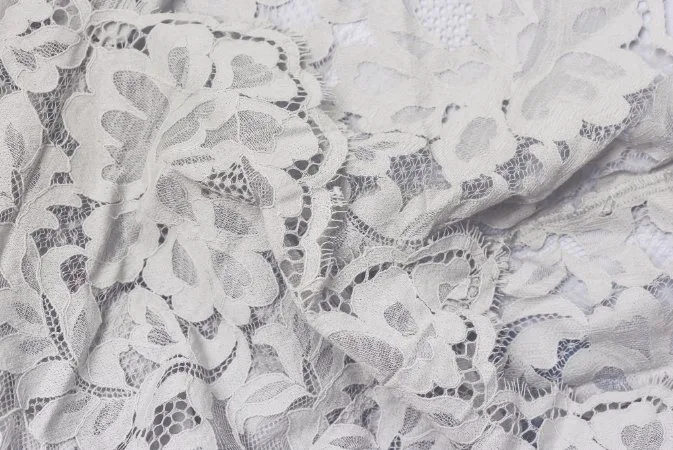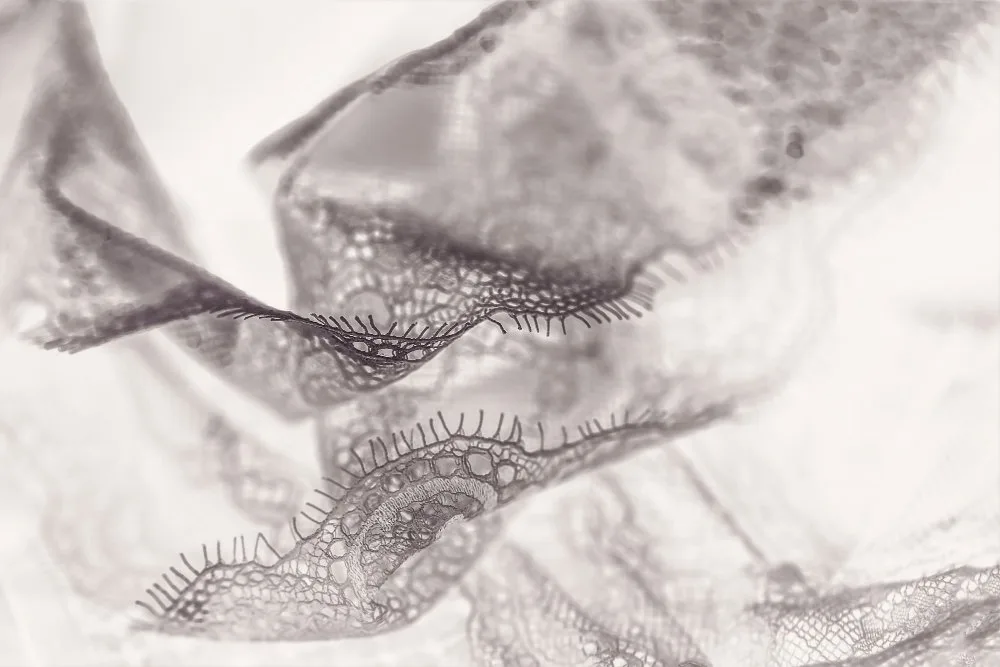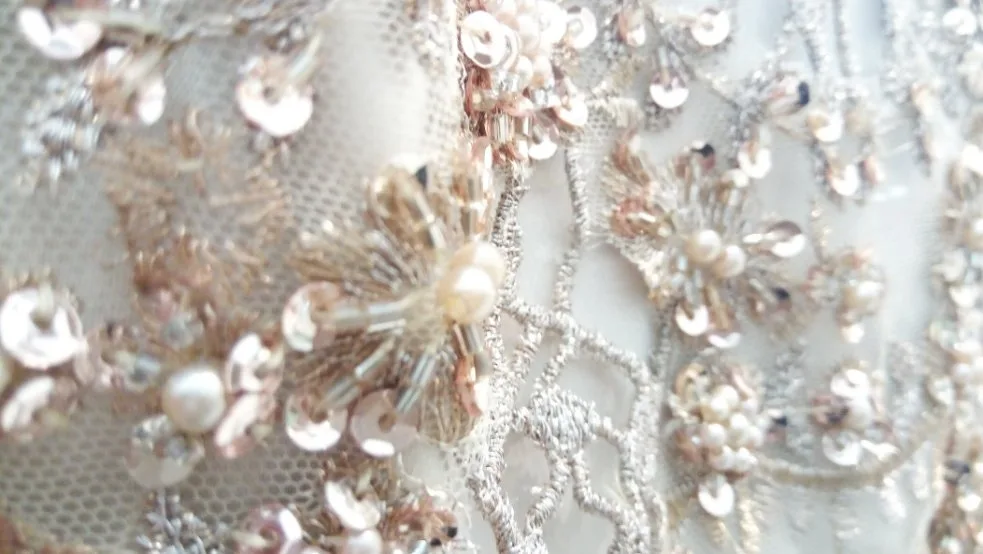From Chantilly to Stretch: Your Complete Guide to Lace Fabric Types, Care, and Applications
Lace fabric captures hearts with its delicate, open patterns made by twisting, looping, or knitting threads. This elegant textile adds sophistication to both fashion and home decor, making it a popular choice for everything from wedding dresses to curtains. Whether you’re a sewing enthusiast, fashion designer, or simply curious about this beautiful fabric, this guide covers everything you need to know about lace.
Table of Contents
What Is Lace Fabric?
Lace fabric is a delicate textile formed by looping, twisting, or knotting threads to create intricate openwork patterns with spaces between the threads. This web-like design makes lace lighter than most solid fabrics, while its detailed patterns can range from simple geometric shapes to elaborate floral motifs.
Key Characteristics of Lace
Lace stands out from other fabrics because of several unique features:
- Open structure: The spaces between threads allow light to pass through
- Lightweight feel: Less dense than woven or knit fabrics
- Complex patterns: Often featuring flowers, leaves, or geometric designs
- Delicate texture: Requires gentle handling and care
- Decorative purpose: Usually used for accents rather than entire garments
The beauty of lace lies in the balance between solid threads and empty spaces, creating patterns that catch light and add visual interest to any item.
If you have a piece of lace and aren’t sure what type it is, try our interactive lace identification quiz to get detailed information about your fabric’s origin, care requirements, and uses.
How Is Lace Made?
Lace production has evolved from hand-crafted artistry to machine manufacturing, though both methods are still used today.
Traditional Hand Methods
Needle Lace: Created using a single needle and thread, this technique builds patterns stitch by stitch. Artisans create tiny stitches that form the final fabric, making it one of the most time-intensive methods.
Bobbin Lace: Made by winding thread onto multiple bobbins (usually around 20) and weaving them around pins placed on a padded pillow. The pins hold the pattern in place while threads are twisted and crossed.
Tatting: A knotting technique that creates rings and chains using a shuttle or needle. This method produces sturdy lace with a distinctive look.
Modern Machine Production
Today, most lace comes from specialized machines that can replicate hand-made patterns quickly and consistently. Raschel knitting machines and Leavers lace machines are the most common types used in commercial production. These machines can create complex patterns in minutes that would take hours to make by hand.
Can lace be made by machine? Yes, and machine-made lace has made this beautiful fabric more affordable and widely available. However, handmade lace remains prized for its unique character and craftsmanship.
Where Is Lace Made?

Lace production occurs worldwide, but certain regions are famous for their expertise:
- France: Known for Chantilly and Alençon lace
- Italy: Famous for Venetian and Burano lace
- Belgium: Renowned for Bruges and Brussels lace
- England: Notable for Nottingham lace
- India: Produces various types including Chikankari embroidered lace
- China: Major manufacturer of machine-made lace for global markets
Which country has the best lace fabric? This depends on the type you’re looking for. France and Italy are often considered the gold standard for luxury handmade lace, while countries like India and China offer excellent machine-made options at various price points.
History of Lace-Making

The art of lace-making dates back to the late 15th and early 16th centuries in Europe. While historians debate its exact origins, lace first appeared prominently in Italian and Flemish paintings during this period.
Timeline of Lace Development
- 15th-16th centuries: Lace emerges in Italy and Belgium
- 17th-18th centuries: Becomes popular among European royalty and wealthy families
- 19th century: Industrial Revolution introduces machine-made lace
- 20th century: Mass production makes lace accessible to everyone
- 21st century: Combines traditional techniques with modern technology
During its early days, lace was extremely expensive and served as a status symbol. Only the wealthy could afford intricate handmade pieces that took months to complete.
Types of Lace Fabric
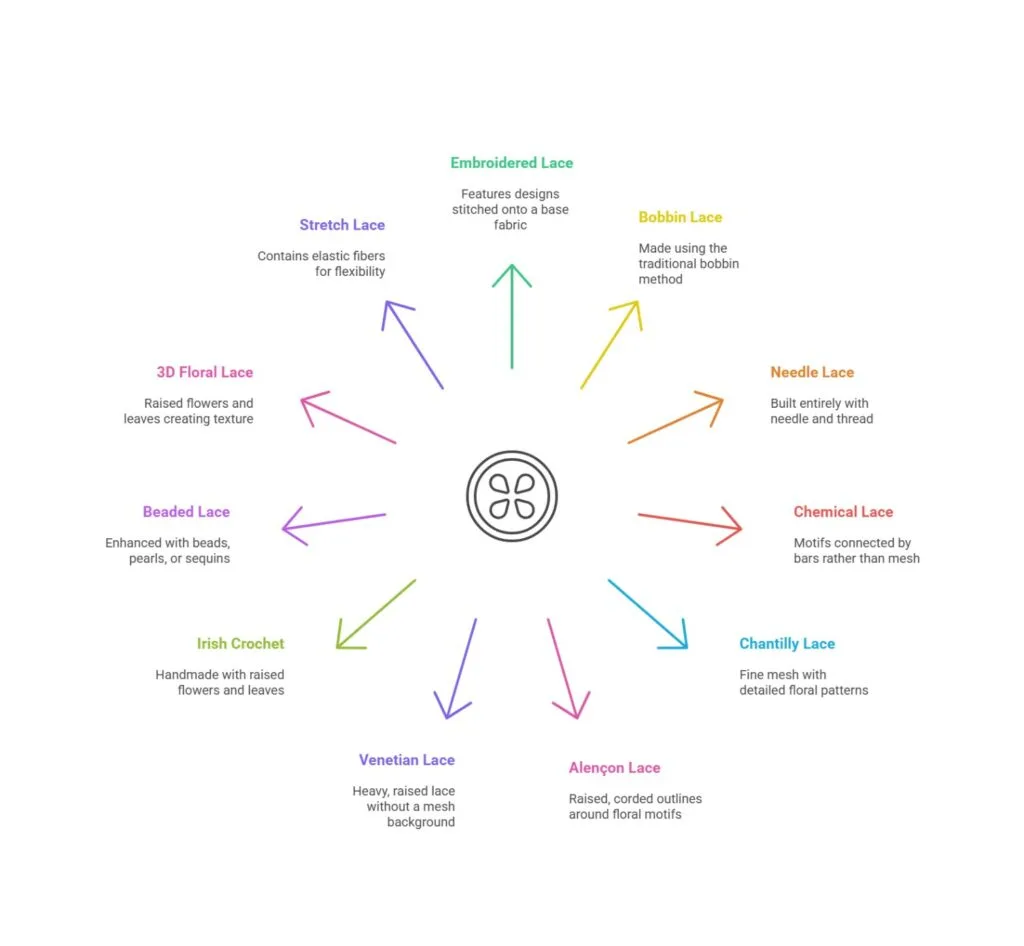
Understanding different lace types helps you choose the right one for your project. Here are the main categories:
By Construction Method
Embroidered Lace
Created by stitching designs onto a base fabric like tulle or mesh. The embroidery can form simple outlines or complex patterns, making this type popular for wedding dresses and special occasion wear.
Bobbin Lace (Pillow Lace)
Made using the traditional bobbin method, this lace has a distinctive woven appearance. Chantilly and Valenciennes laces fall into this category.
Needle Lace
Built entirely with needle and thread, creating raised patterns without a background mesh. Venetian lace is the most famous example.
Chemical Lace (Guipure)
Machine-made lace where motifs are connected by bars rather than mesh. This creates a bold, structured appearance perfect for statement pieces.
By Pattern and Style
Chantilly Lace
Features fine mesh backgrounds with detailed floral patterns outlined in thicker thread. Originally from France, it’s popular for bridal wear and evening gowns.
Alençon Lace
Distinguished by raised, corded outlines around floral motifs. This French lace often has a scalloped edge and is considered very elegant.
Venetian Lace
Heavy, raised lace without a mesh background. Motifs connect directly to each other, creating a bold, three-dimensional appearance.
Irish Crochet
Handmade using crochet techniques, featuring raised flowers and leaves connected by mesh backgrounds.
By Decorative Elements
Beaded Lace
Enhanced with glass beads, pearls, crystals, or sequins sewn onto the fabric. This adds weight and sparkle, making it ideal for evening wear and special occasions.
3D Floral Lace
Features raised flowers and leaves that stand out from the base fabric, creating texture and visual interest.
Stretch Lace
Contains elastane or spandex fibers, allowing it to stretch and recover. Perfect for fitted garments and lingerie.
Is lace stretchy? Most traditional lace is not stretchy, but modern stretch lace incorporates elastic fibers for flexibility. This makes it suitable for form-fitting clothes and activewear.
With so many lace types available, choosing complementary varieties for layered projects can be challenging. Our lace pattern matching tool helps you find perfectly coordinated lace combinations based on texture, scale, and desired visual effect.
What Is Lace Made Of?
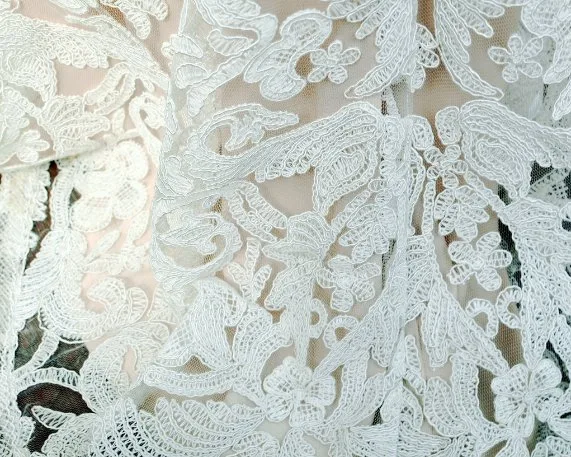
Lace can be crafted from various materials, each offering different characteristics:
Natural Fibers
Cotton Lace
Cotton creates soft, breathable lace with a matte finish. It’s comfortable against skin and easy to dye, making it popular for everyday items and children’s clothing.
Benefits:
- Absorbs moisture well
- Gentle on sensitive skin
- Takes dye easily
- Durable with proper care
Silk Lace
Luxury silk creates the finest, most expensive lace. It has a natural sheen and drapes beautifully, making it perfect for high-end fashion and bridal wear.
Benefits:
- Luxurious feel and appearance
- Natural shine
- Excellent drape
- Lightweight yet strong
Linen Lace
Less common but creates crisp, structured lace perfect for home decor items like tablecloths and curtains.
Synthetic Fibers
Understanding the differences between natural vs synthetic fabrics helps you choose the right lace for your needs.
Polyester Lace
The most common synthetic option, polyester lace resists wrinkles and holds its shape well. It’s affordable and easy to care for.
Benefits:
- Wrinkle resistant
- Colorfast
- Quick drying
- Budget-friendly
Nylon Lace
Extremely fine and strong, nylon creates delicate-looking lace that’s actually quite durable. It’s stretchy and commonly used in lingerie.
Benefits:
- High strength
- Natural stretch
- Resistant to damage
- Lightweight
Rayon Lace
Made from wood pulp, rayon combines some benefits of both natural and synthetic fibers. It has a silk-like appearance but costs less.
Learning more about common fabric types can help you understand how lace fits into the broader textile world.
How to Identify Different Types of Lace
Recognizing lace types becomes easier when you know what to look for:
Visual Clues
Pattern Style:
- Floral motifs: Often Chantilly or Alençon
- Geometric patterns: Usually modern machine-made
- Raised elements: Likely Venetian or Irish crochet
- Fine mesh background: Probably Chantilly or similar
Construction:
- Connected motifs without mesh: Chemical or Guipure lace
- Obvious grid pattern: Machine-made
- Irregular, handmade appearance: Artisan-crafted
Touch Test
Texture:
- Soft and flexible: Likely cotton or silk
- Slightly stiff: Often polyester or treated cotton
- Very fine: Probably silk or high-quality nylon
- Stretchy: Contains elastic fibers
Uses of Lace Fabric
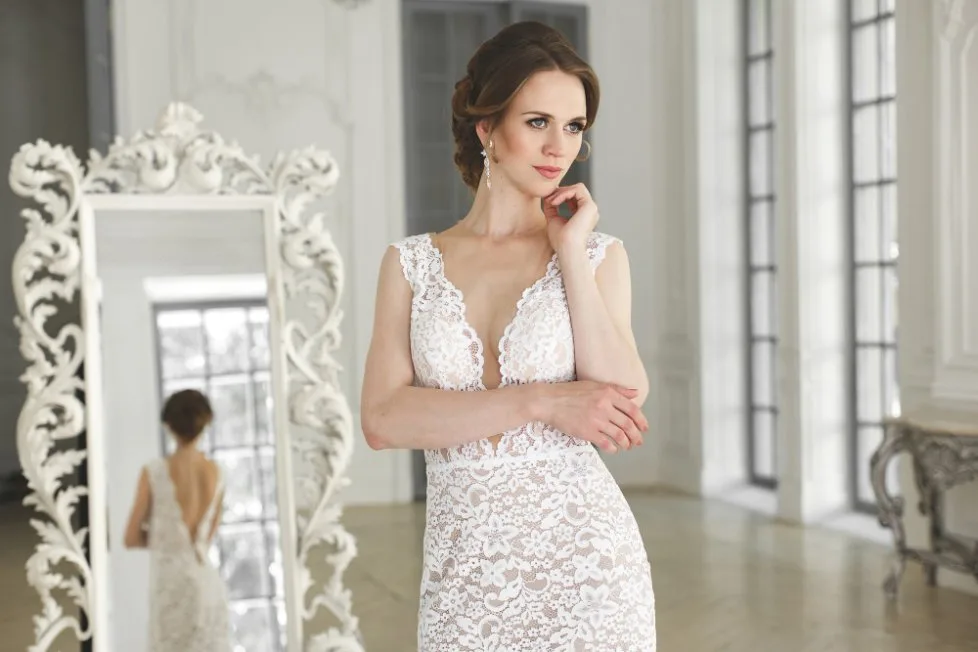
Lace serves many purposes in both fashion and home decor:
Fashion Applications
Wedding and Bridal Wear
Lace remains the top choice for wedding dresses, veils, and accessories. Its romantic appearance and traditional associations make it perfect for special occasions.
Everyday Clothing
Modern fashion incorporates lace into casual wear through:
- Lace trim on sleeves and hems
- Sheer lace panels in tops and dresses
- Lace underlayers for texture
Lingerie and Intimate Apparel
The delicate nature of lace makes it ideal for:
- Bras and panties
- Camisoles and slips
- Nightgowns and robes
Accessories
Lace enhances accessories like:
- Scarves and wraps
- Hair accessories
- Handbags and purses
Home Decor Uses
Window Treatments
Lace curtains provide privacy while allowing light to filter through, creating beautiful patterns on walls and floors.
Table Linens
Tablecloths, runners, and placemats made from lace add elegance to dining spaces.
Decorative Accents
Lace works well for:
- Pillow covers and cushions
- Lampshade covers
- Doilies and decorative mats
When combining multiple lace types in a single project, coordination is key to achieving professional results. Our pattern coordination tool provides expert guidance on mixing textures, scales, and styles.
2025 Lace Fabric Trends

The lace industry continues evolving with new styles and applications:
Minimalist Lace
Simple, clean patterns that add subtle texture without overwhelming the design. Perfect for modern, understated looks.
High-Contrast Designs
Bold combinations like black lace over bright colors create dramatic visual impact.
Sustainable Lace Options
Eco-friendly lace made from organic cotton, recycled fibers, or innovative materials like bamboo.
Athleisure Integration
Lace panels in activewear and casual sportswear blend feminine details with functional design.
Vintage-Inspired Styles
Revival of classic patterns and techniques appeals to those seeking timeless elegance.
How Much Does Lace Cost?
Lace prices vary dramatically based on several factors:
Price Factors
Material Quality:
- Synthetic lace: $5-20 per yard
- Cotton lace: $10-40 per yard
- Silk lace: $30-100+ per yard
- Vintage or antique lace: $50-500+ per yard
Planning your budget is crucial when working with quality lace. Use our project cost calculator to estimate total expenses including fabric, notions, labor, and additional materials for accurate budget planning.
Production Method:
- Machine-made: Generally less expensive
- Handmade: Significantly more costly
- Designer or couture: Premium pricing
Complexity:
- Simple patterns: Lower cost
- Intricate designs: Higher price
- Beaded or embellished: Most expensive
Is lace expensive? It can be, especially handmade or designer varieties. However, machine-made synthetic lace offers affordable options for most projects.
Where to Buy Lace
Retail Options:
- Fabric stores and craft shops
- Online retailers and marketplaces
- Specialty lace suppliers
- Wedding and bridal shops
Wholesale Sources:
- Textile trade shows
- Manufacturer direct sales
- Bulk fabric suppliers
- Import/export companies
Where can you buy wholesale lace? Professional suppliers, textile districts in major cities, and specialized online platforms offer wholesale pricing for larger quantities.
Caring for Lace Fabric: Complete Guide
Proper care extends the life of your lace items significantly. Here’s everything you need to know:
Care requirements vary significantly depending on your lace’s type, age, and material. Get personalized washing, drying, and storage instructions with our comprehensive lace care generator tailored to your specific piece.
Washing Lace
Hand Washing (Recommended)
Step 1: Preparation
- Fill a basin with cool water (60-80°F)
- Add mild detergent designed for delicate fabrics
- Test for colorfastness on a hidden area first
Step 2: Washing
- Gently place lace in soapy water
- Let it soak for 5-10 minutes
- Lightly agitate by pressing through the water
- Avoid rubbing, scrubbing, or twisting
Step 3: Rinsing
- Drain soapy water
- Rinse with clean, cool water several times
- Continue until all soap residue is gone
- Support the lace when lifting to prevent stretching
Machine Washing
When machine washing is necessary:
- Place lace in a mesh laundry bag
- Use delicate or gentle cycle
- Choose cool water temperature
- Select mild detergent for delicates
- Avoid fabric softener
Never machine wash:
- Vintage or antique lace
- Heavily beaded pieces
- Very delicate silk lace
- Items with loose threads
Drying Lace
Air Drying (Best Method)
Flat Drying:
- Lay clean towel on flat surface
- Place damp lace on towel
- Gently press another towel on top to absorb moisture
- Reshape while slightly damp
- Allow to air dry completely away from direct sunlight
Hanging:
- Only for sturdier lace pieces
- Use padded hangers to prevent stretching
- Avoid hanging heavy or wet lace
Machine Drying
Never use a dryer for lace. The heat and tumbling action can:
- Melt synthetic fibers
- Shrink natural fibers
- Tangle delicate threads
- Damage beads or embellishments
Ironing Lace
Can you iron lace? Yes, but with extreme caution:
Safe Ironing Steps:
- Set iron to lowest heat setting
- Use a pressing cloth between iron and lace
- Iron on the wrong side when possible
- Move iron gently – don’t drag
- For delicate pieces, use a steamer instead
How to iron a lace dress:
- Turn dress inside out
- Use pressing cloth
- Work in small sections
- Pay special attention to seams and hems
- Hang immediately after ironing
Storing Lace
Proper storage prevents damage during periods of non-use:
Short-term Storage:
- Hang on padded hangers (lightweight pieces)
- Lay flat in drawers with tissue paper
- Keep away from direct sunlight
Long-term Storage:
- Wrap in acid-free tissue paper
- Store flat in breathable boxes
- Include lavender sachets to deter insects
- Check periodically for any issues
Avoid:
- Plastic bags (can trap moisture)
- Cedar chests (oils can stain)
- Hanging heavy pieces (causes stretching)
- Folding along pattern lines
Stain Removal and Restoration
Common Lace Problems
Yellowing: Vintage lace often yellows with age. Why does lace turn yellow? Exposure to light, air pollution, and improper storage cause this discoloration.
How to fix yellowed lace:
- Soak in mixture of equal parts white vinegar and cool water for 30 minutes
- Rinse thoroughly with clean water
- For stubborn yellowing, try oxygen bleach (never chlorine bleach)
- Air dry completely
Stains:
- Treat immediately when possible
- Blot, don’t rub
- Use mild soap and cool water
- Test cleaning method on hidden area first
Professional Cleaning
Consider professional services for:
- Valuable vintage pieces
- Wedding dresses and heirloom items
- Heavily soiled or stained lace
- Items you’re unsure how to clean
Cost: Professional lace cleaning typically ranges from $20-100+ depending on the item’s size and condition.
Dyeing Lace Fabric
Can you dye lace? Yes, but the process requires care and consideration:
What Lace Can Be Dyed
Natural fibers like cotton and silk take dye well Synthetic fibers may not accept dye or may react unpredictably Blended fabrics will dye unevenly
Dyeing Process
Can you dye lace black? Black is one of the easiest colors to achieve and covers imperfections well.
Basic Steps:
- Choose appropriate dye for your lace material
- Test on a small, hidden area first
- Follow dye manufacturer’s instructions exactly
- Use cool water to prevent shrinkage
- Rinse thoroughly after dyeing
Special Considerations:
- Can you dye a lace wedding dress? Yes, but consider the sentimental value first
- Some laces have treatments that resist dye
- Beaded or embellished lace may not dye evenly
Professional Dyeing
For valuable items or when you want guaranteed results, professional dyeing services offer:
- Color matching expertise
- Experience with delicate fabrics
- Insurance against damage
- Better equipment and dyes
Sewing with Lace
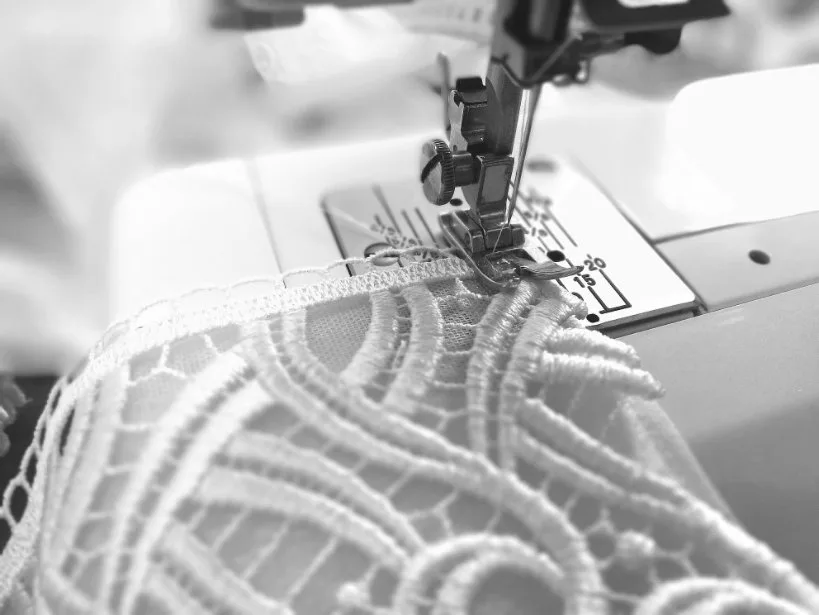
Working with lace requires special techniques and considerations:
Cutting Lace
How to cut lace:
- Use sharp fabric scissors
- Cut along pattern lines when possible
- Leave extra seam allowance
- Mark cutting lines with washable markers
- Support fabric while cutting to prevent stretching
Sewing Techniques
Tips for sewing lace:
- Use sharp, fine needles (size 9-11)
- Choose thread that matches the lace
- Sew slowly to maintain control
- Use tissue paper under delicate lace
- Test stitches on scraps first
How to sew stretch lace:
- Use ballpoint or stretch needles
- Select appropriate stretch stitches
- Don’t stretch fabric while sewing
- Use woolly nylon thread for better stretch
How to sew lace onto fabric:
- Pin carefully to avoid snagging
- Baste first if necessary
- Use appropriate seam types for the application
- Finish seams to prevent fraying
Seam Types for Lace
French seams work well for sheer lace as they enclose raw edges Flat-fell seams provide durability for items that need frequent washing Serged/overlocked edges prevent fraying on cut edges
This comprehensive knowledge of sewing techniques will help you work successfully with lace fabrics.
Specialty Lace Types

Regional and Traditional Varieties
Venetian Lace
What is Venetian lace? This raised, needle lace originated in Venice, Italy. It features bold, three-dimensional patterns without a mesh background, making it perfect for statement pieces and haute couture.
Indian Lace Fabric
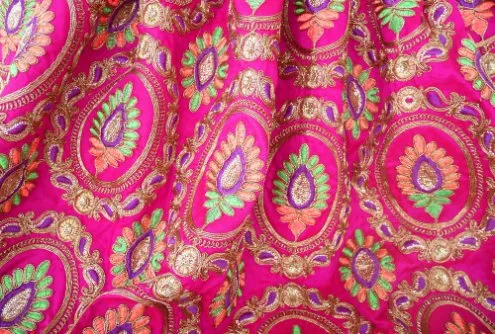
What is Indian lace fabric? India produces various lace types, including:
- Chikankari: Traditional white embroidery on fine cotton
- Mirror work lace: Incorporates small mirrors for sparkle
- Zardozi: Uses metallic threads for luxury appeal
Tatting Lace
What is tatting lace? A shuttle lace technique creating rings and chains through knotting. What is the difference between lace and tatting? Tatting is a specific type of lace-making technique, while lace is the broader category of open-work fabrics.
Terminology and Professionals
What do you call a person who makes lace? A lacemaker or lace artisan. Professional lacemakers often specialize in specific techniques or regional styles.
What is handmade lace called? Artisan lace, hand lace, or by its specific technique name (needle lace, bobbin lace, etc.).
Quality and Value
What is the most expensive type of lace? Hand-made needle lace, particularly Alençon and some Venetian varieties, can cost hundreds of dollars per yard.
What is the most delicate lace? Fine silk Chantilly lace ranks among the most delicate, requiring extremely careful handling.
What is a heavy lace called? Guipure, Venice lace, or any lace with significant raised elements and thick threads.
Comparing Lace Types
| Type | Origin | Characteristics | Best Uses | Price Range |
|---|---|---|---|---|
| Chantilly | France | Fine mesh, floral patterns | Bridal wear, veils | $20-80/yard |
| Alençon | France | Raised cord outline | Formal gowns | $30-100/yard |
| Venetian | Italy | No mesh, raised patterns | Statement pieces | $40-150/yard |
| Guipure | Various | Connected motifs | Structured garments | $15-60/yard |
| Stretch | Modern | Contains elastic | Lingerie, fitted clothes | $10-40/yard |
Lace vs Other Fabrics
What fabric is similar to lace? Eyelet fabric shares the open-work characteristic but typically has simpler, geometric holes rather than intricate patterns.
Is lace just crochet? No, while some lace is made using crochet techniques, lace encompasses many different construction methods including knitting, weaving, and embroidery.
What is the difference between lace and poly? This likely refers to polyester lace versus other materials. Polyester lace is more durable and wrinkle-resistant but may lack the drape and luxury feel of natural fiber laces.
Shopping Guide

Quality Assessment
When shopping for lace, evaluate:
Pattern Quality:
- Are motifs complete and well-defined?
- Do patterns align properly?
- Are edges clean and finished?
Material Quality:
- Does the fabric feel appropriate for its fiber type?
- Are threads even and strong?
- Is the color consistent throughout?
Construction Quality:
- Are seams and connections secure?
- Does stretch lace recover well after stretching?
- Are any beads or embellishments securely attached?
Quantity Planning
How much lace do I need? This depends on your project:
- Trim: Measure the perimeter plus 10% extra
- Full garment: Use pattern yardage requirements
- Home decor: Measure area plus hem allowances
Buying Tips
- Order all lace from the same dye lot for consistent color
- Buy extra for testing and mistakes
- Consider shipping costs when comparing prices
- Read return policies carefully for fabric purchases
Troubleshooting Common Issues

How to Stretch Lace Fabric
Can you stretch lace? Only stretch lace containing elastic fibers should be stretched. For slight relaxation of other laces:
- Dampen slightly with water
- Gently coax into desired shape
- Pin in place while drying
- Never force or yank
Repair Techniques
Small holes: Use matching thread to weave across the gap Loose edges: Secure with tiny hand stitches Detached beads: Reattach using original holes when possible
When to Seek Professional Help
Contact textile conservators for:
- Valuable antique lace
- Large tears or significant damage
- Preservation for long-term storage
- Insurance evaluations
Planning Your Lace Project
Whether you’re working on a wedding dress, home décor project, or fashion piece, proper planning ensures beautiful results:
Step 1: Identify Your Lace
Not sure what type of lace you have? Upload a photo to our lace identification tool for detailed analysis including origin, characteristics, and recommended uses.
Step 2: Plan Your Budget
Calculate total project costs including fabric, notions, and labor with our comprehensive cost calculator. Get money-saving tips and realistic budget estimates.
Step 3: Choose Coordinating Fabrics
If you’re combining multiple lace types, use our pattern matching tool to find perfectly complementary combinations based on your desired effect.
Step 4: Create Care Instructions
Generate personalized care guidelines with our lace care generator to protect your investment and maintain beauty long-term.
Conclusion
Lace fabric continues to captivate us with its delicate beauty and intricate craftsmanship. From its origins in 15th-century Europe to today’s innovative synthetic blends, lace has adapted while maintaining its essential charm and elegance.
Essential Points to Remember
- Material Matters: Understanding whether your lace is made from natural or synthetic fibers directly impacts how you should care for it. Cotton and silk laces require gentler treatment than polyester varieties.
- Care is Critical: Proper washing, drying, and storage techniques can extend your lace’s life dramatically. Remember that hand washing in cool water and air drying are almost always the safest choices.
- Quality Recognition: Learning to identify different lace types and assess quality helps you make better purchasing decisions and choose the right lace for your specific project.
- Versatility in Use: Modern lace applications extend far beyond traditional uses. From athleisure wear to home decor, lace continues finding new purposes while maintaining its classic appeal.
Practical Recommendations
- For Beginners: Start with machine-made cotton or polyester lace. These are more forgiving to work with and easier to care for while you develop your skills.
- For Special Projects: Invest in quality silk or high-grade cotton lace. The difference in drape, appearance, and longevity justifies the higher cost for important items.
- For Regular Wear: Choose stretch lace blends for comfort and durability in everyday garments. They maintain their shape better and are less likely to tear with normal use.
- For Home Decor: Consider the room’s usage when selecting lace. High-traffic areas need more durable, washable options, while decorative pieces can prioritize beauty over practicality.
To make the most of your lace projects, take advantage of our free planning tools: identify unknown lace with our fabric quiz, generate personalized care instructions, calculate project costs, and find coordinating lace combinations.
Looking Forward
The lace industry continues evolving with sustainable options, new synthetic materials, and innovative production techniques. As we move through 2025, expect to see more eco-friendly lace options and creative applications in unexpected areas like activewear and technology accessories.
Understanding lace fabric empowers you to make informed decisions whether you’re shopping for a special occasion dress, planning a sewing project, or simply appreciating this remarkable textile. With proper knowledge and care, lace items can provide beauty and elegance for years to come.
Whether you’re drawn to the romance of vintage Chantilly, the bold drama of Venetian lace, or the practical beauty of modern stretch varieties, there’s a lace type perfect for your needs. The key lies in understanding your options, caring for your pieces properly, and appreciating the artistry that goes into every yard of this timeless fabric.
Remember that lace is more than just fabric, it’s a connection to centuries of textile artistry and human creativity. By choosing, using, and caring for lace thoughtfully, you become part of this continuing tradition of beauty and craftsmanship.
For more fabric care guides and textile information, explore our comprehensive resources on fabric care and textile types.
Frequently Asked Questions
General Questions
How many types of lace fabric are there?
There are dozens of lace types, with the main categories being needle lace, bobbin lace, chemical lace, and embroidered lace. Each category includes numerous subtypes and regional variations.
How do you describe lace?
Lace is a delicate, open-work fabric featuring intricate patterns created through various techniques like knotting, looping, or embroidering threads. It’s characterized by its combination of solid elements and open spaces.
Is lace fabric good?
Lace is excellent for decorative purposes, special occasion wear, and adding feminine touches to garments. However, it requires careful handling and isn’t suitable for high-wear applications.
What is the most common lace?
Machine-made polyester lace with simple floral patterns is probably the most widely available and used type today.
Care and Maintenance
How long does it take to make lace?
Hand-made lace can take anywhere from hours for simple pieces to months or even years for complex, large items. Machine-made lace produces yards in minutes.
Is lace still made by hand?
Yes, artisans worldwide still create handmade lace, though it represents a small fraction of total lace production. Handmade lace commands premium prices and is often considered art.
What is the best lace in the world?
This is subjective, but many consider French Chantilly and Alençon laces, Italian Venetian lace, and Belgian Bruges lace among the finest due to their craftsmanship and heritage.
Specialized Applications
What is lace vs lace front?
This refers to wigs and hair pieces. A lace front wig has lace only at the hairline for a natural appearance, while a full lace wig is constructed entirely on a lace base.
Why are lace fronts so expensive?
Lace front wigs require hand-tied individual hairs into the delicate lace base, making them labor-intensive and time-consuming to produce.
How long does a lace front last?
With proper care, a quality lace front wig can last 6 months to 2 years, depending on usage and maintenance.
Technical Questions
What is needlepoint lace?
Needlepoint lace (or needle lace) is made entirely with needle and thread, building patterns stitch by stitch without a woven base. Venetian and Alençon laces are famous examples.
What is the end of a lace called?
The finished edge of lace is often called the “heading” (the straight edge meant for attachment) or “footing” (the decorative scalloped edge).
Free Lace Planning Tools
Take the guesswork out of your lace projects with our expert tools:
- Lace Identification Quiz – Upload a photo to identify lace type and get detailed information
- Care Instructions Generator – Get personalized washing, drying, and storage guidance
- Project Cost Calculator – Plan your budget with accurate cost estimates
- Pattern Matching Tool – Find perfectly coordinated lace combinations
All tools are free to use and provide instant, expert-level guidance for your lace projects.

